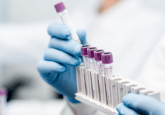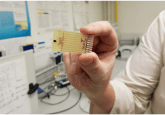Novel biosensor has the potential to rapidly detect Influenza A

Sensors based on surface acoustic waves (SAW) can be utilized to detect very small amounts of antigens of the Influenza A virus. The biosensors, developed by researchers from A*STAR Institute of Materials Research and Engineering (Singapore), have the potential to detect viral infections quickly and reliably, making them powerful tools for preventing future pandemics.
There are three strains of influenza ― Influenza A, B and C ― of these it is Influenza A that is associated with deadly pandemics. It is therefore essential to rapidly identify the dangerous Influenza A strain.
Kui Yao from the A*STAR Institute highlighted the limitations of current influenza detection techniques: “Of the two conventional methods for detecting Influenza A, one is non-quantitative, not specific enough, and often unreliable and inconclusive, whereas the other is time-consuming, expensive and requires trained professionals.”
To provide a better detection method the researchers produced sensors by coating lithium niobate, a piezoelectric material, with silicon oxide. They then formed a bioactive surface by immobilizing Influenza A antibodies on the sensor.
The SAW response of the sensor changed when antigens of Influenza A bound to the immobilized antibodies on the sensor surface. Therefore, by monitoring the SAW signal of a sensor, usually at very high frequencies, the researchers could detect antigens with a sensitivity of at least one nanogram per millilitre.
This is the first time that a SAW-based biosensor has been utilized to selectively detect targeted Influenza A antigens by immobilizing Influenza A antibodies.
Yao explained, “These results indicate the potential of using SAW sensors to detect libraries of pathogens and to further act as a cost-effective platform for rapid clinical diagnosis.”
SAW sensors are very attractive due to their simplicity and ability to be mass produced. “Our SAW sensors have a high sensitivity and are quantitative, low cost and easy enough to be potentially used at clinics,” commented Yao.
In future work the researchers hope to further improve the sensor’s design and performance, and apply it to the clinic by working with physicians.
Sources: Jiang Y, Tan CY, Tan SY et al. SAW sensor for Influenza A virus detection enabled with efficient surface functionalization. Sensors and Actuators B: Chemical 209(31), 78–84 (2015); Sounding out flu viruses.






